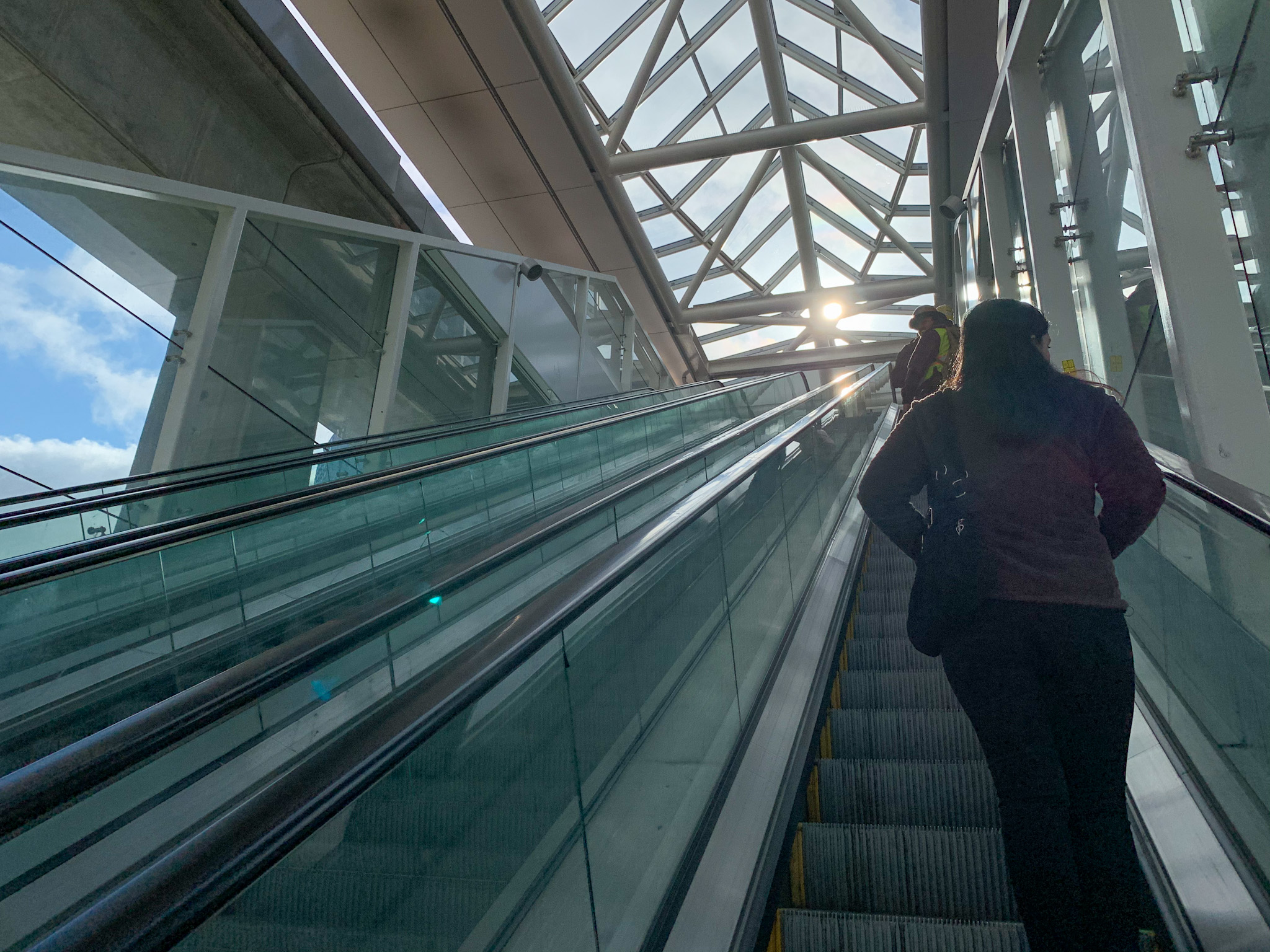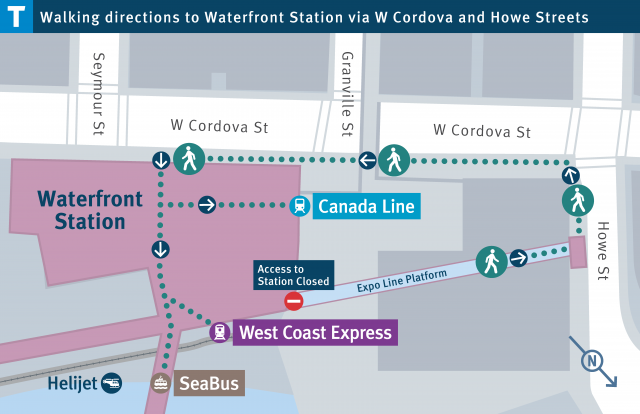Why are escalators at SkyTrain stations out of service so often?
Why are escalators at SkyTrain stations out of service so often?


It may feel like it, but surprisingly, escalators at SkyTrain stations are not out-of-service that often.
Across the SkyTrain network, monthly escalator availability during January 2020 was 99.42 per cent for the Canada Line, and 93 per cent for the Expo and Millennium Lines.† During the rest of the times when an escalator was unavailable, it usually wasn’t because it was broken, but rather it was undergoing inspection.
There are three types of inspections that happen over the course of year.
- Monthly: includes checking all external safety devices to ensure they are functioning and a visual of all exterior parts. This inspection takes approximately two hours per unit.
- Quarterly: involves removing 10 steps, cleaning the top and bottom interior ends of the escalator, checking all internal and external safety devices, and inspecting the interior for wear or damage. This inspection takes approximately two days per escalator.
- Annually: involves removing 50 per cent of the total steps in the escalator, cleaning the entire inside, checking the entire escalator for wear or damage, and inspecting all safety devices. This inspection takes approximately five days per escalator.
These inspections are part of our rigorous and robust maintenance program to ensure our escalators are safe and reliable for our customers, and ensures we maximize the escalator’s life expectancy.
“Because of this program many customers believe that our escalators are continuously out of service due to break downs when actually we are performing maintenance,” explains Harry Schmidt, manager of elevating devices at SkyTrain.
“Usually our inspections go as planned, and the escalator can be returned to service in a timely manner. However, if our escalator technicians discover any device or part that affects the safety of the unit during inspections, it must be repaired before it can carry customers again.”
Repair times for escalators can vary, especially when there’s a fault during the day. A fault happens when the escalator’s onboard computer detects there’s an issue and out of an abundance of caution, it automatically stops running until an escalator technician inspects it.
Escalators have many interconnected and interdependent parts, so faults can be difficult and time consuming to diagnose and repair. Technicians often must make several visits before a repair can be completed. We also have a mix of escalators from different manufacturers and time periods across our system.
For example, the escalators at our Expo Line stations have been in service since 1986 when the SkyTrain first opened, so that means spare parts for these escalators have become obsolete. There’s no Home Depot for escalator parts that our technicians can pick up what they need from, so parts must be manufactured and that has a long lead time.
The escalators at SkyTrain stations are also workhorses that operate about 21 hours per day and carry its maximum capacity for most of the day, far exceeding what you’d normally see in shopping centres, department stores and hotels that might carry hundreds in a day. Our escalators carry thousands. Waterfront, our busiest station, sees close to 40,000 boardings on a typical day. Not only that, our Expo Line escalators carry four times the number of people as it did in 1986.
Think of a car. The more you drive it, the more often it needs to get its oil changed. Or think of your shoes, the more you wear them, the sooner they wear out and a new pair is needed.
The time has come for our Expo Line stations to get some new shoes!
The Expo Line Escalator Replacement Project’s replacing 37 escalators at 13 SkyTrain Stations along the Expo Line and at select West Coast Express stations. It’s already underway at Granville, Commercial–Broadway and Columbia stations.
At Waterfront Station, work started last month on one of the two escalators at the Howe Street entrance. We’re now beginning work on the escalators leading from the Expo Line platforms up to the concourse for the SeaBus and West Coast Express. These escalators carry about 15,000 people in either direction on an average weekday.
This means, starting on May 11 until the end of the year, customers exiting the Expo Line at Waterfront Station will need to use Howe Street, near Canada Place.
Customers transferring from Expo Line to Canada Line, SeaBus or West Coast Express will exit the station at Howe Street and re-enter through the Cordova entrance. This will add approximately 5-10 minutes to people’s trips.
The elevator near the closed escalators will remain open for those who need it only, to use as normal. A SkyTrain Attendant will be present on-site to assist those who need the elevator.
The staircase from the concourse down to the platform will be entrance only. Customers will still be able to enter the station at Howe Street for Expo Line only.
This critical investment is part of the TransLink Maintenance and Repair Program to keep escalators operating safely and reliable for customers well into the future.
“Replacing these escalators with modern equipment means having escalators that are designed to be safer for the customers and fewer major breakdowns,” says Harry. “We know it’s an important customer amenity.”
At heart of every project is safety and how do we minimize the impact to our customers, while completing necessary work in timely manner to maintain our system.
That’s why we’re expediting this work at Waterfront Station while ridership is low to limit the number of people impacted as much as possible. This project was originally planned to begin later, after the summer surges in SkyTrain customers during the busy cruise ship season and large summer celebrations such as Canada Day and the Celebration of Light. Completing critical maintenance and repair work now will prepare our system for when ridership begins to return to normal levels sooner.
One final tidbit on escalators is from time-to-time, customers might find escalators blocked off with no escalator technicians working on it. You may be wondering, “Why can’t we use it as stairs?” There’s a good reason why that’s the case and it has to do with safety.
The escalator could be waiting for parts for repair or it could have been closed by a SkyTrain Attendant because they discovered a safety issue.
There could be a rocking step or somethings protruding that could injure a customer. As well, if a customer falls on an escalator, it will be closed until a full inspection can be completed to ensure the escalator wasn’t the reason why they fell or got injured.
There’s your 411 on why escalators are always out-of-service “so often!” The short answer is it’s usually for maintenance. When we are planning to take an escalator out of service for maintenance, we’ll alert our customers through Transit Alerts at alerts.translink.ca.
†The figures for the Expo and Millennium Lines are high-level estimates based on available information obtained from manual reporting of outages. The figures for Canada Line are based on data from an automatic tracking system.







could you publish a proper map? See Lougheed station map.
A low-cost way to help mitigate the public perception of breakdowns would be to post signs at such escalators proclaiming “regular maintenance” or “safety inspection” or something to that end.